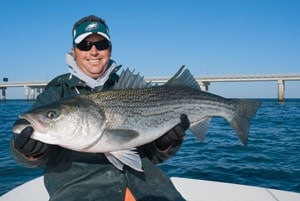
About the time this article hits the streets, there may be some new fishing regulations for striped bass, and part of the reason for them is simple common sense. They have been controversial, as most new fishing regulations are these days. They have pitted segments of the recreational fishery against each other, which is not beneficial. But we happen to think that this kind of common sense ought to be embraced and even expanded.
The basis for the differences in opinion in this case centers on the increased recreational targeting of large, prespawning female striped bass in Chesapeake Bay. The proposed regulations would cover March and three weeks of April and would restrict the number of fishing days each week. They also would restrict the use of bait, limit the number of fishing rods on a trolling boat and spell out the types of hooks that can be used. The bottom line in this effort is to protect the most valuable asset that striped bass anglers have: mature, fertile females that are ready to spawn and produce the future of this fishery. If we cannot ensure that the spawning stock biomass is protected, then we cannot possibly ensure that the fish have a viable future.
In this debate, charter captains have supported the measure and individual anglers have opposed it. One side points fingers at the other, indicating this is an effort for one side to get more of the resource than the other. What we really need to do is to make sure the resource is properly protected, and then we can argue about shares. But if there are no fish, we have nothing to argue about.
While the information is anecdotal, there have been continuing reports about the decline in striped bass fishing along the Atlantic Coast. For the last five years, Stripers Forever, which is an online organization fighting for game-fish status of stripers, has conducted a survey of its members. They recently published the 2009 survey results tallied from just under a thousand responding members from virtually all the Atlantic coastal states. One of the primary questions focused on the quality of striped bass fishing, and 69 percent responded that it was “much worse or worse” over the last five years.
The National Marine Fisheries Service, through the Marine Recreational Information Program, also keeps statistics on the number of striped bass caught. The preliminary numbers for 2009 show a continuing decline that has occurred every year since 2006, with a precipitous drop between 2008 and 2009. In 2006, there were 28.6 million striped bass caught by recreational anglers. For 2009, that number was 6.9 million. In 2007, the drop from the previous year was 33 percent. In 2008, it was 27 percent. In 2009, it was 50 percent.
At the same time, we have seen some fairly weak young-of-the-year indexes. This index is one of the major components of the stock assessment. None of these things alone are the smoking gun that would prove a substantial problem. They are all, however, pointing in the same direction, which should make managers and anglers all the more cautious.
While this management action is directed at striped bass in their major spawning area, it has implications beyond management of just striped bass. It is something that may need serious consideration for many species, and as a management tool, it will not be accepted easily. In many commercial fisheries, managers have taken steps not just to control the impacts on spawning fish but to curtail these impacts while fish are aggregated for the purpose of spawning. If we do not have good year classes of juvenile fish recruiting to the spawning biomass, the future for recreational fishermen is dim at best. Since recreational anglers use the least-efficient fishing gear, we need to have the resource at high levels to maintain strong catches.
In some fisheries, recreational anglers have minimal impact. In some fisheries, we are part of the problem. And in some fisheries, we are the problem. While individual angler impact is not measurable, the cumulative impact of millions of anglers is substantial. Recreational users should not always think that commercial fishermen are the primary cause for stock decline. That being said, there is nothing wrong with recreational use and consumption of common property resources. They belong to all of us, and we do not have to apologize for using them. We simply have to recognize that there are limits to the use of these resources and that we are part of the process to manage them sustainably.
As more and more of the U.S. population moves to coastal areas, there will be more demand for and use of our marine resources by recreational interests. Although there have been some successful management stories in resources important to recreational anglers, we need to be aware that there is a finite resource and an increasing potential for demands on that resource. We will see more restrictions, not fewer. Not everyone, maybe even no one, will like them, but they are inevitable. We just need to do what we can to make them as fair as possible while maintaining the health of the resource.
The sooner recreational interests understand that we are part of the problem, the sooner we will be able to be an important part of the solution.









